We’re all gamers on the lookout for awesome monitors here at What’s The Best, so we were eager to get our hands on AOC’s most affordable and well-specced curved gaming screen. Aimed at PC and console gamers looking for more immersion from a curved display, the AOC Gaming CQ27G2SE gaming monitor is a 27-inch 1440p model capable of variable refresh rates up to 165Hz. With HDR10 support, Adaptive Sync and a range of features to enhance gameplay, the monitor is an evolution of the previous CQ27G1 model – adding better clarity and a more pronounced curve.
This is not a 4K screen – but that’s a bonus, and here’s why: 1440p gaming monitors are highly popular with fans of both new and old titles. Yes, games that run at 4K with high frame rates are becoming more common, but PC users will need a serious GPU and other high-spec hardware to run them smoothly. Gaming at 1440p is still generally preferred for better performance at higher frame rates across both PC and consoles. So, those who want the best out of their games at Quad HD could be in for a serious performance boost. Our tech expert and Skyrim addict, Chris Duffill, has hooked it up to his PC and Xbox Series X. Did he hang up his controller in display dismay, or was he stuck to the screen slaying dragons all night?
Pros
- Excellent immersion over flat screens thanks to the curved panel
- Plenty of tweakable settings and gaming features like 165Hz refresh rate and Adaptive Sync
- Solid build with a refined gamer aesthetic
Cons
- 1440p - not 4K (but you need to want to sacrifice some performance for 4K, so only a con for serious 4K fans)
| Resolution | 2560 x 1440 (QHD) |
| Screen size | 27 inches |
| Screen type | Curved VA panel |
| Refresh rate | 165Hz |
| Response time | 1ms (MPRT) |
| HDR | HDR10 |
| Ports | : 2 x HDMI 2.0, 1 x DisplayPort 1.2, 1 x Audio line-out |
| Colour support | 120% sRGB, 92% DCI-P3 |
| Brightness | 250 nits |
| Viewing angle | 178° horizontal / 178° vertical |
Following the curve
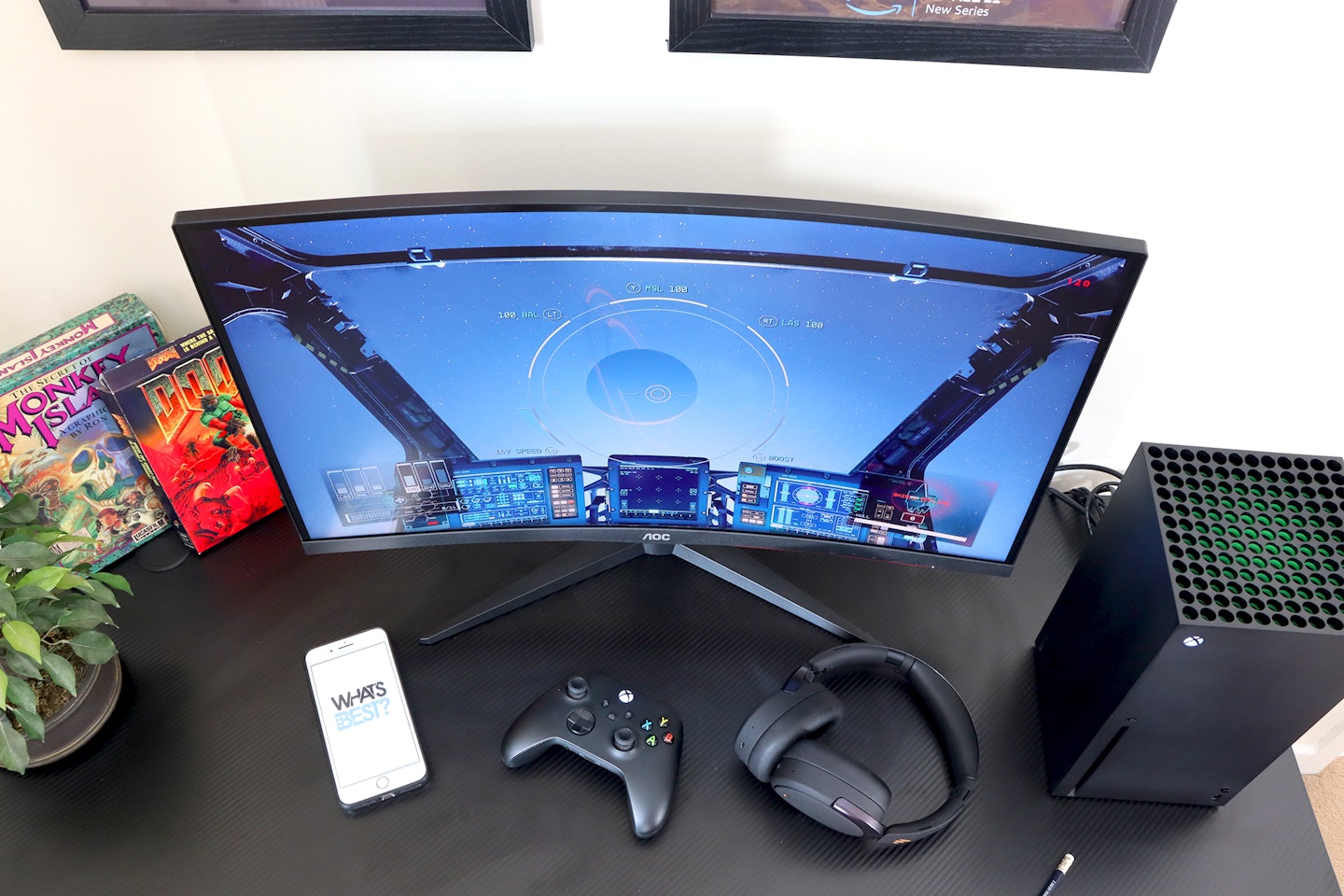
Having been a designer, I’ve never taken to the idea of a curved screen. After all, the idea of a straight line looking curved is a bit of a disconcerting prospect. But, gamers love them for their subtle wrap-around effect, increasing immersion by following the curve of your eye. Up until now, I’ve either used a 31-inch monitor or a 50-inch QLED TV for my PC and Xbox gaming. This one is a 144Hz VA model with WQHD resolution and support for Adaptive Sync, so I was intrigued by how it might perform. But, all of that came a close second to that 1500R curved panel. Would it improve my sense of immersion as I raced, explored and gunned my way through my virtual worlds?
Performance tests
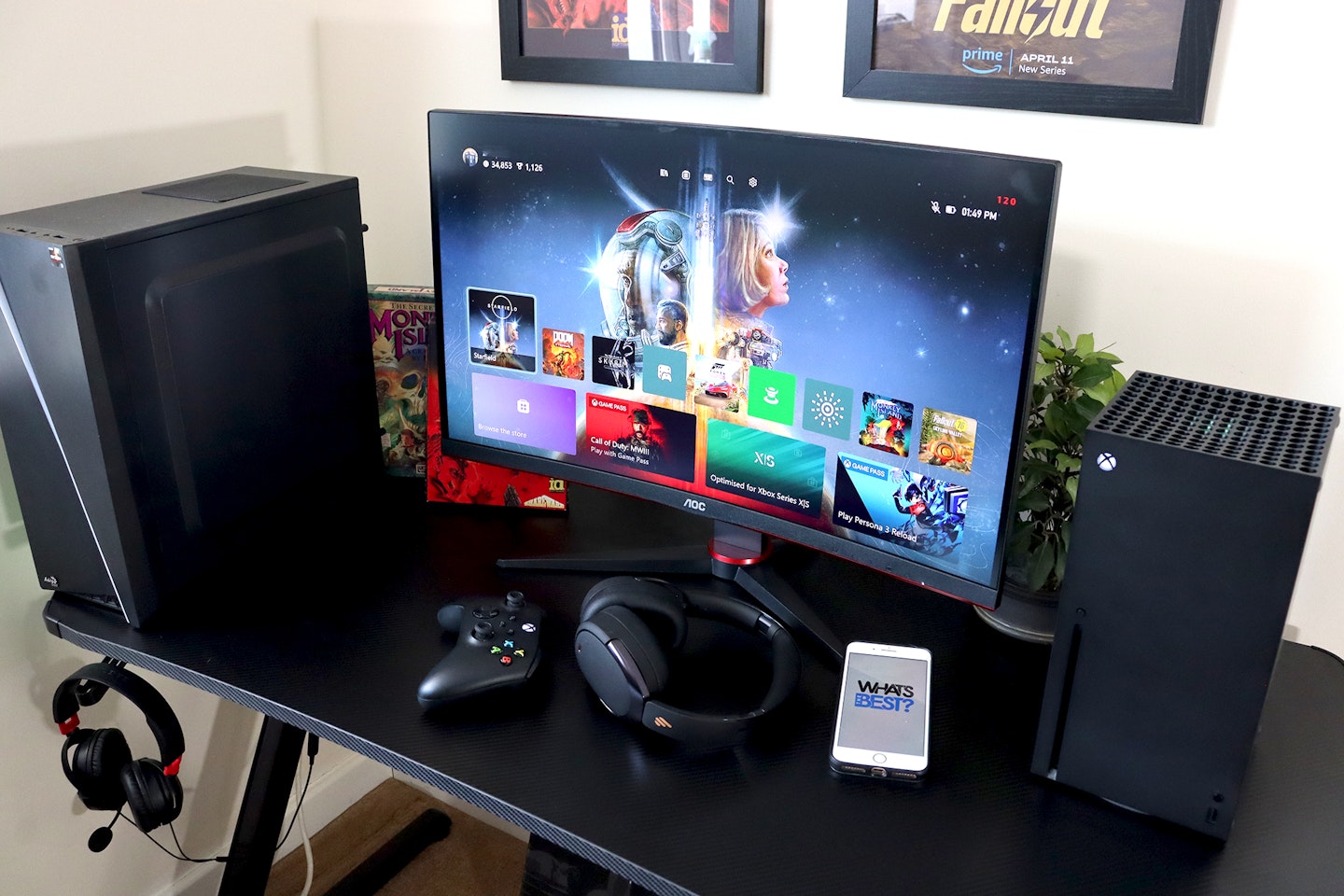
I’m a fan of first-person shooters and RPGs, but I also like to have a quick blast on racing and arcade games. I also stream videos on my Xbox from time to time, so the AOC was in for a thorough workout.
The features I kept an eye on were the framerates (both supported and reported on-screen), motion clarity, response time and input lag. Lastly, but perhaps the most important to me, was whether the AOC Gaming CQ27G2SE monitor’s 1500R curve would make me feel a little more immersed in my games. Here’s what I played the most:
Xbox Series X
Skyrim - tested at 60 fps
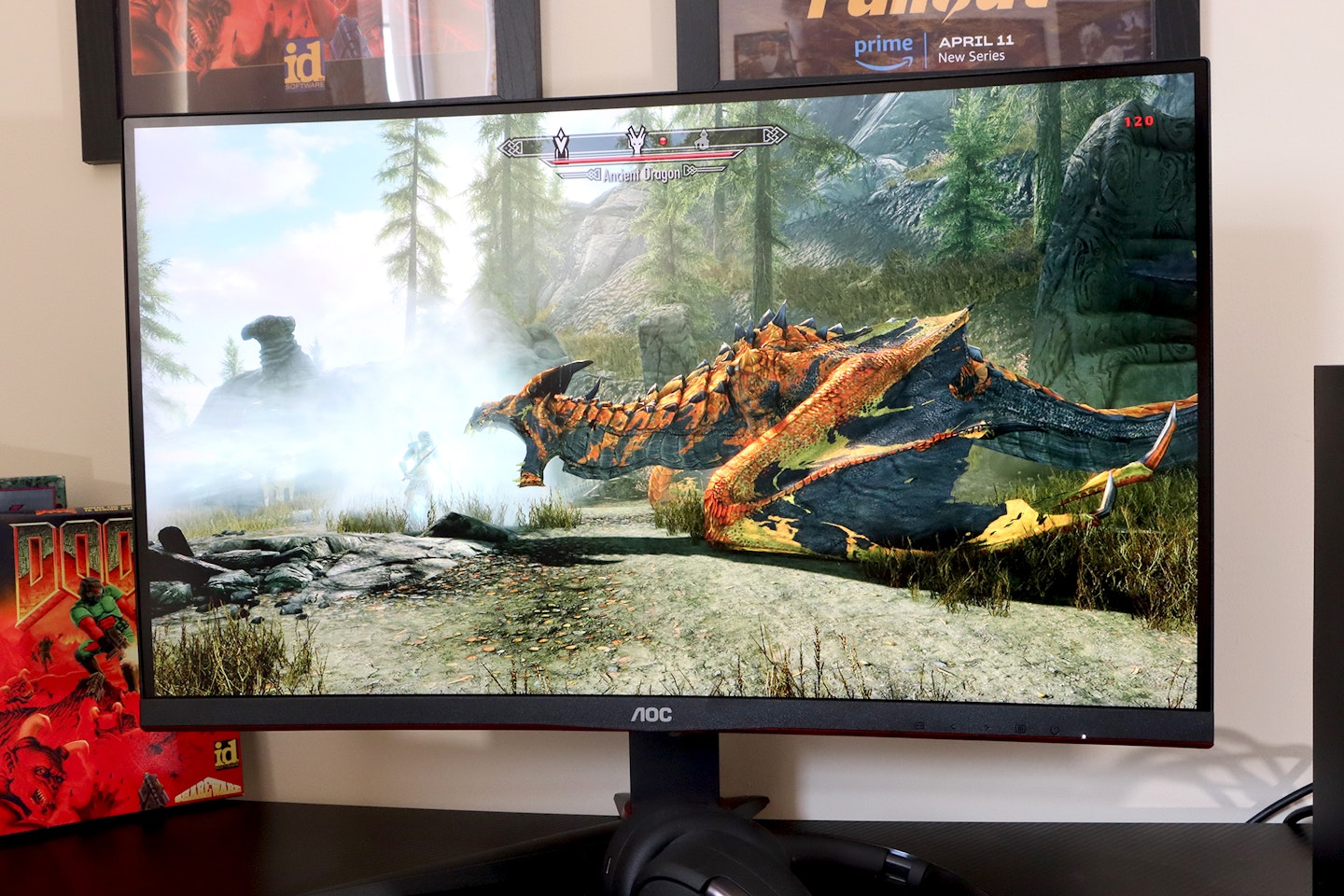
DOOM Eternal - tested at 120fps setting
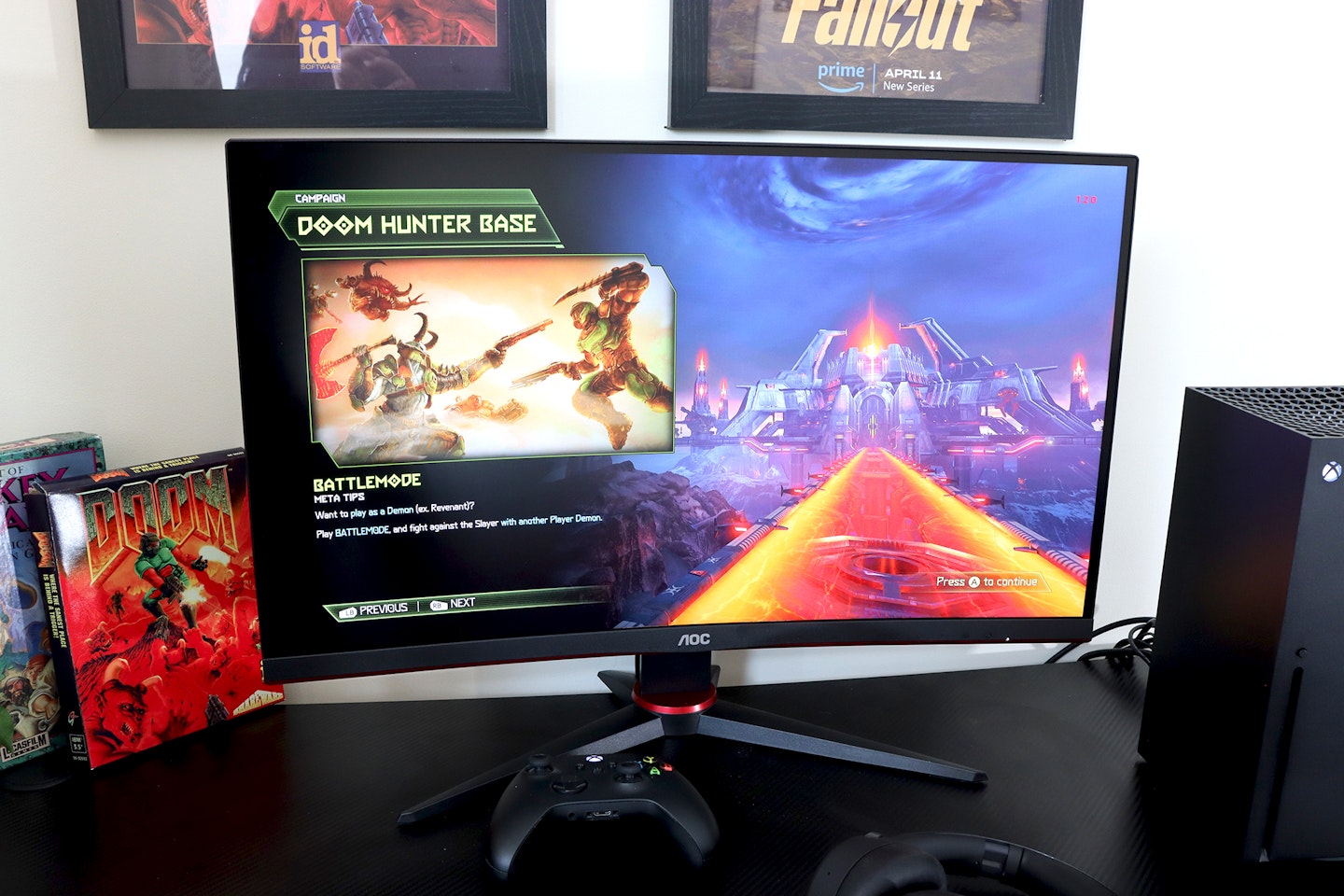
Forza Horizon 5 - tested at 40fps (max performance mode) setting
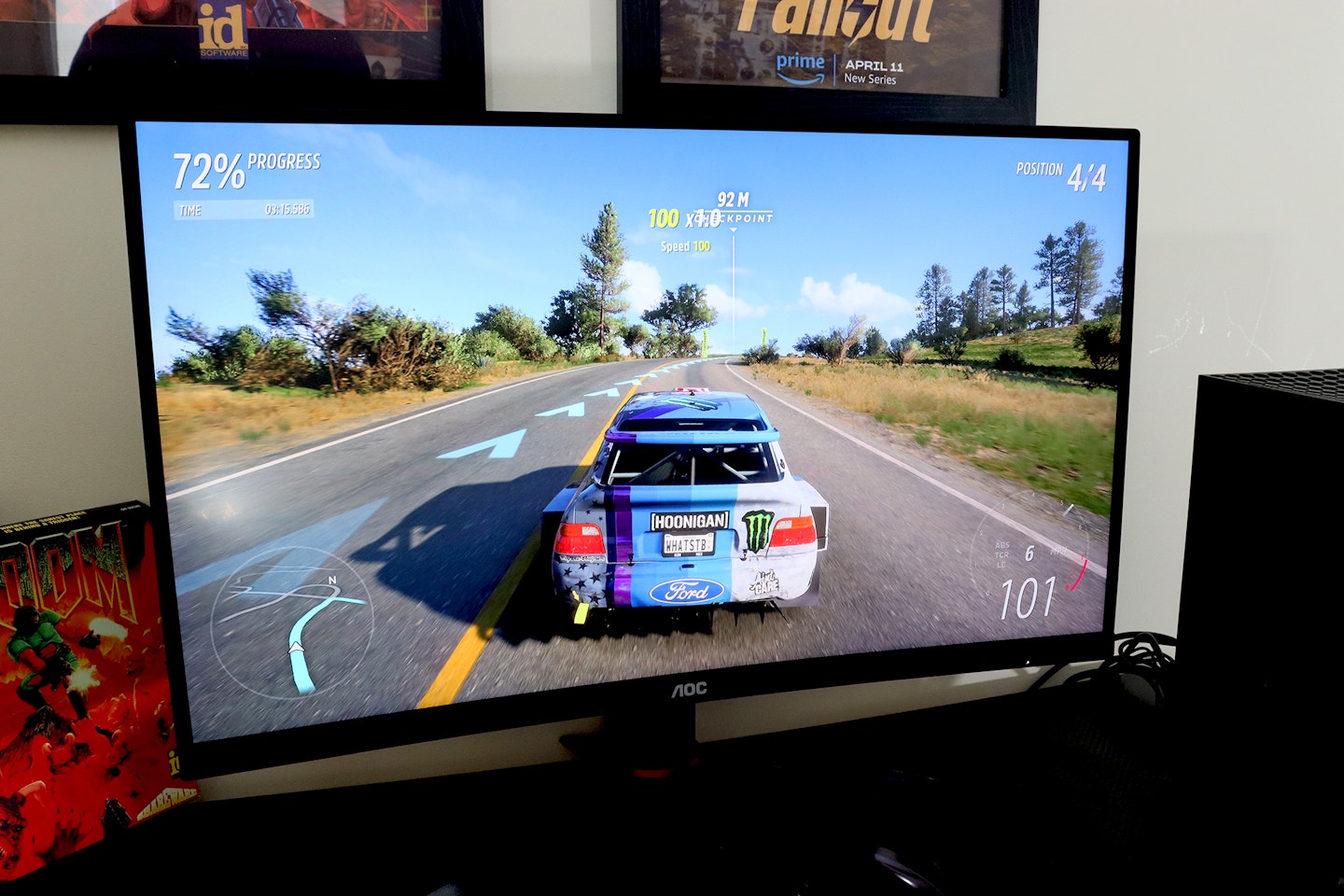
Starfield - tested at 60fps
PC
Rocket League - tested at 165fps setting
Performance verdict: How good is it?

No matter what game I played, I noticed no input lag or glaring response time issues. As a 1440p monitor, I appreciated that it could downscale a 4K input too. Although the AOC does support HDR10 (more on that in our guide to monitor HDR), it’s worth mentioning that the Xbox Series X can only output HDR at 4K – a resolution this monitor doesn’t support. So, HDR is only really available with other devices like PCs.
Frame rates were rock-solid to the eye, and according to the monitor’s on-screen display, this topped out at the Xbox’s maximum of 120fps with compatible games. Rocket League on PC fared better as it could be set to 165fps – matching the max refresh rate of the monitor. And I didn’t see any noticeable tearing or dropped frames in any of my games, so that’s a big win for AOC’s Adaptive Sync feature.
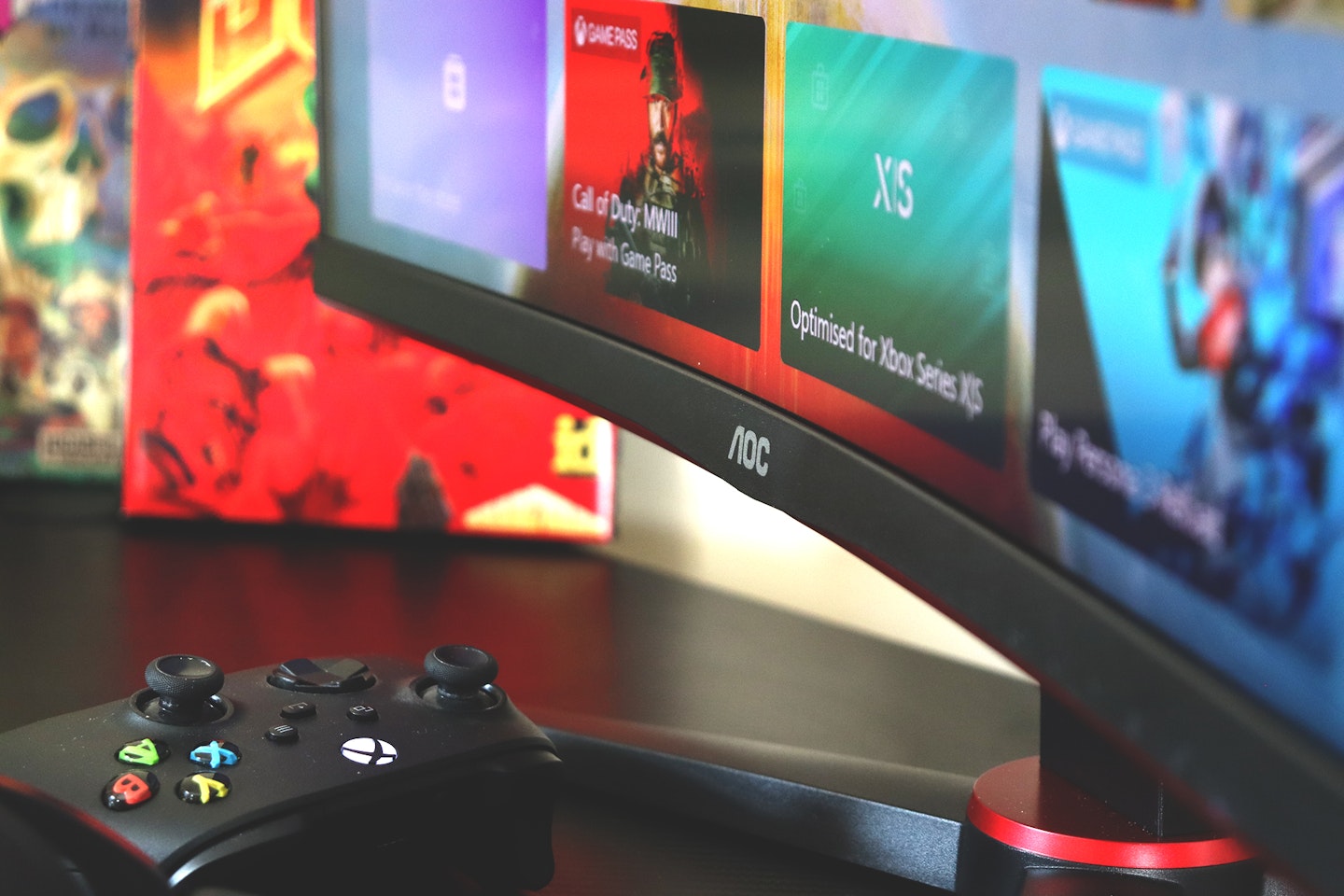
As for motion clarity, I did notice some blurring with fast action against dark backgrounds – that’s due to the VA panel – but that’s really because I was looking for it. Otherwise, I didn’t find it noticeable during play. That said, I did use AOC’s Overdrive setting on the medium setting by default – it’s a feature that helps to eliminate ghosting with fast motion if you need it. If you’d like to know more about how VA panels work, check out our guide to display panel types.
Lastly, that curved immersion. Although a 1500R curve isn’t the tightest one to be found, it’s certainly better than the previous models' 1800R curve. Compared to my larger flat monitor, I did find that I got a little more lost in my game worlds with this AOC than usual. It's possible that I’ve become a curved gaming monitor convert.
Gunning for gamers
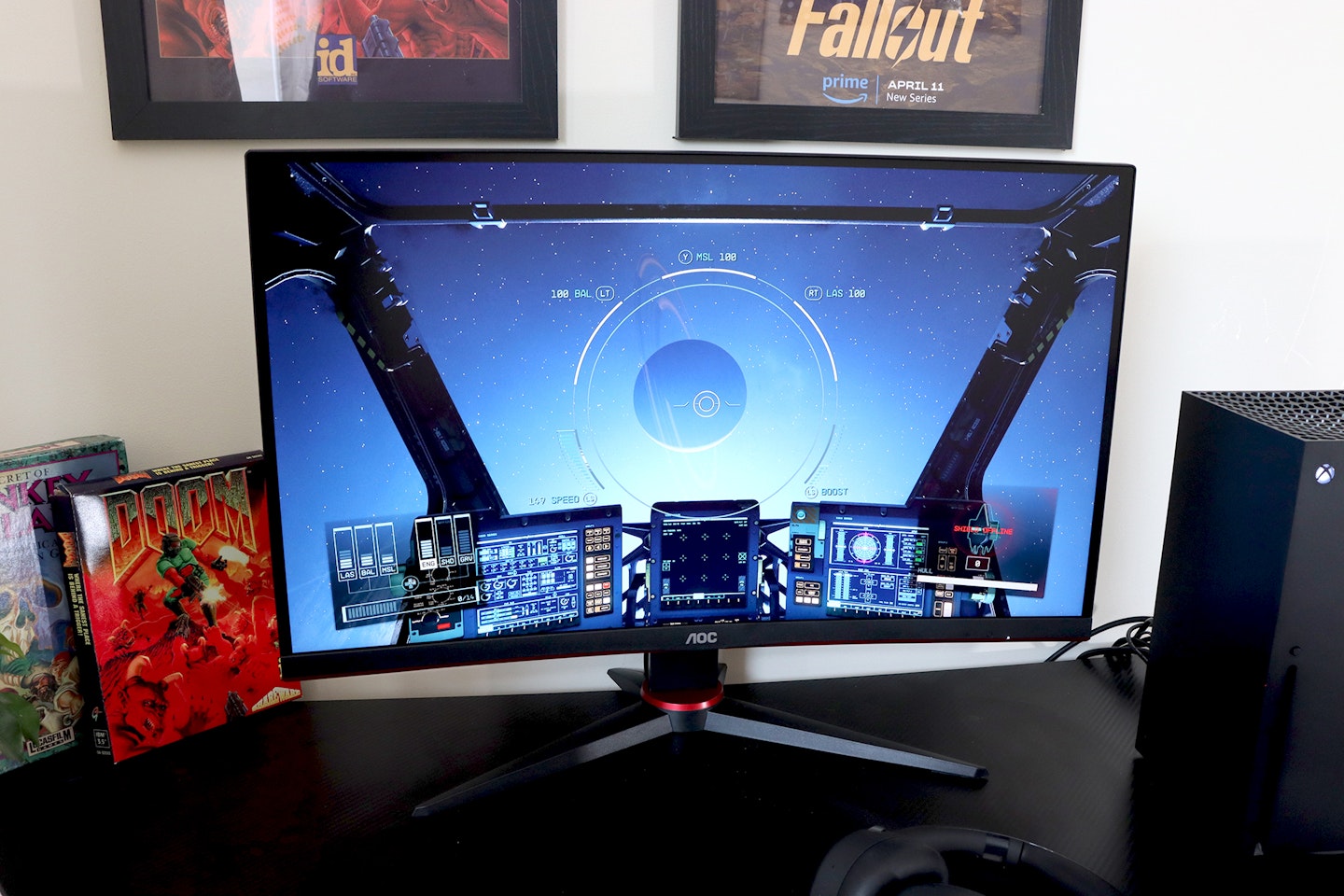
I really like AOC’s approach to ticking all of the boxes gamers want, including many dedicated features that surprised me at this price point. I found the on-screen display intuitive and fairly simple to cycle through the options, too.
Here are the standout features that I either found useful or enhanced my gaming experience:
Shadow Control
Although this is pitched as a way to enhance shadow detail, I actually used it to achieve the deep black levels that I prefer when gaming. As I mentioned earlier, out of the box the monitor’s defaults are quite bright. Tweaking the usual image adjustments didn’t quite do it for me, so the Shadow Control feature (a sliding scale with 10 levels) made it perfect.
Frame rate counter

Whenever I get a new game that claims a certain framerate, I want to be able to check it easily without relying on in-game tools. Turning on this monitor feature is quick and easy, but I also appreciated being able to choose which corner of the screen it appears on.
Adaptive Sync and Overdrive
Probably my favourite feature of this or any PC or Xbox Series X gaming monitor is the Adaptive Sync capabilities. After all, a 1440p screen capable of 165Hz really should be able to monitor the incoming framerate and self-adjust to ensure judder-free gaming. Like most gamers, I do like to get the best out of my tech, so setting games to max settings and seeing what performance I can squeeze out of it is a must. The AOC gave me no headaches here, action was smooth and uninterrupted. And that’s probably partly due to turning the Overdrive feature on to help reduce ghosting by pushing the monitor’s response time to the limit.
Overall Picture quality
After some tweaking and customising to suit my preferences with colour, brightness and shadow control, I found the AOC CQ27G2SE to be much better in all of those areas than I was expecting. Out of the box, it was overly bright and a little washed out. I initially set it up using my Xbox’s step-by-step calibration tool, followed by the odd tweak here and there once I ran my games. Black levels are more than decent for a VA LCD panel, and I think a lot of that comes down to the Shadow Control feature that opens up tighter control over them.
Even though the Xbox Series X doesn’t support it at 1440p, HDR was a welcome addition – evident during my PC gaming and video sessions – making it a contender for one of the best monitors for PC gaming. Colours are vibrant and brightness levels are more than I needed, so I reduced it to suit. All in all, I found I had plenty of control over the image quality when I needed it, and the display is more than capable of making game visuals and 3D environments that much more nuanced in light, shade and hue.
The screen itself has a nice anti-glare appearance and I only noticed some reflections when sunlight shone directly into my room. Viewing angles were good, too.
Design and build

When I unpacked the AOC Gaming CQ27G2SE I was immediately impressed by its weight and understated gamer aesthetic. The dark red accents on the bezel and base really set off the look. All of the plastics are of a good quality and the stand is nice and heavy with some good height and tilt adjustments. At the back, there are a couple of HDMI 2.0 ports, a DisplayPort and a headphone jack. I appreciate that the rear panel design isn’t an afterthought, as the gamer accents continue there too – ideal for any gaming rig that has its back to the room.
Any downsides?
Other than the fact that this isn’t a 4K-capable screen (which not all gamers want, especially if you’re into slightly older games or want stutter-free super-high framerates) there’s very little not to like about the AOC Gaming CQ27G2SE. But, I did find some minor niggles, such as the lack of a USB port. I like the added flexibility of being able to plug a USB hard drive or thumb drive into a monitor at times, as well as for keeping things charged up – not an option here.
As it happens, my desk isn’t perfectly level and I’ve run out of adjustments there, so I would have liked the monitor mount on the stand to be able to rotate a little. But, this one only has tilt and height. Not a deal-breaker of course, but a nice-to-have.
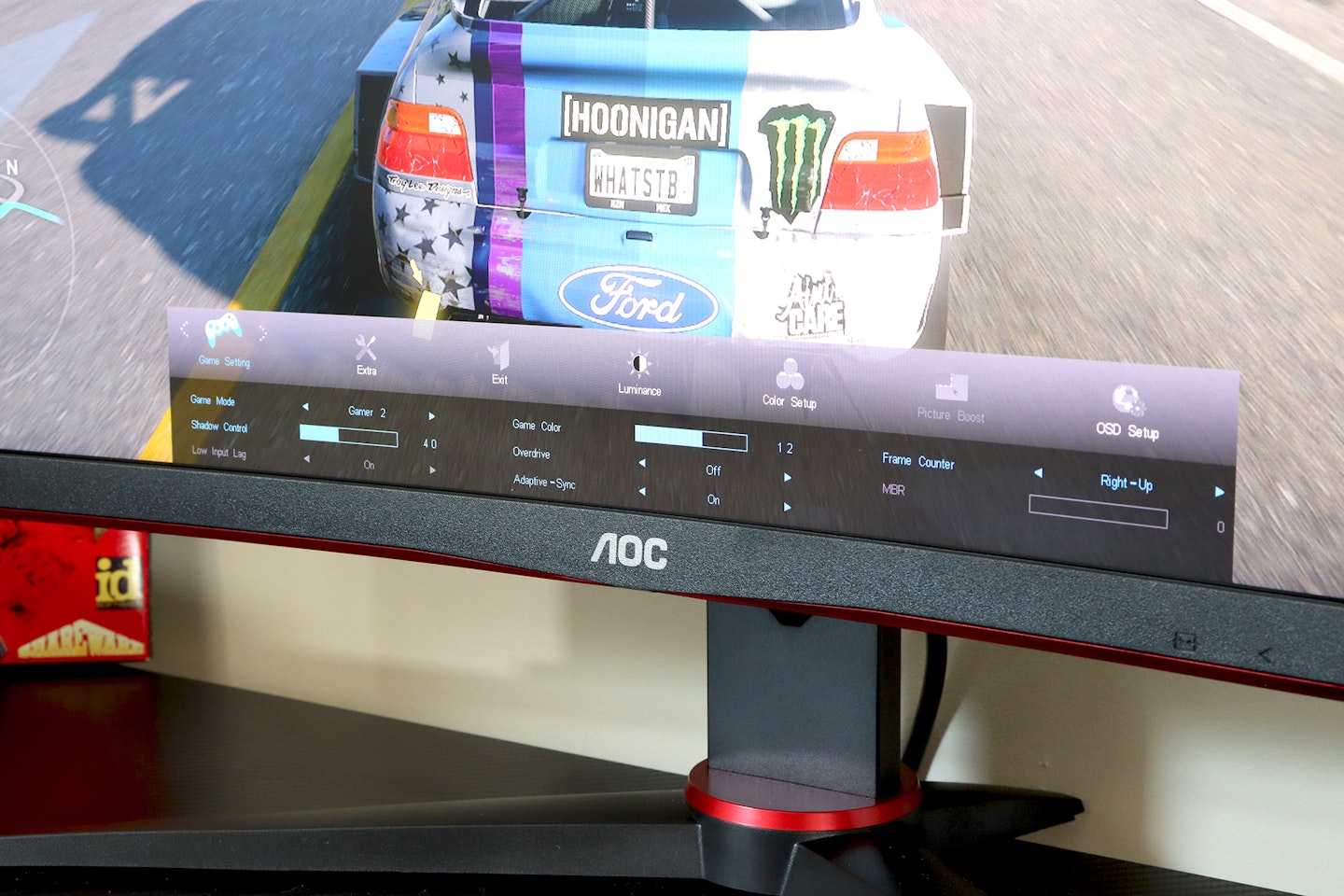
Lastly, the control buttons are underneath on the right-hand side, with subtle icons in the bezel to let you know where they are. Having connected everything up, I used the monitor controls to explore the options. Unlike some screens that put their controls at the back of the panel, I did find pressing upwards a little more arduous than with others at times, but after the initial setup that was less of an issue. That said, I would have preferred the buttons to be back-mounted, or even better a small multifunction joystick to make nipping in and out of options a lot faster and easier.
Price and competition
I can see why this monitor is so popular. Price-wise, it’s approaching the budget bracket, but somehow manages to pack in some great gamer-friendly features and satisfying performance.
If you’re an Xbox gamer looking for a larger 4K screen, I think that one of the best TVs for Xbox might be a more cost-effective option in terms of sheer screen size; But, when it comes to response time and variable refresh rate (and immersion), a dedicated curved gaming monitor is the better and cheaper option – but go larger if you can afford it.
For those of us who like 27-inch screens, close alternatives to the AOC Gaming CQ27G2SE are the Dell S2722DGM 27-inch Curved Gaming Monitor and the MSI G27CQ4 E2 monitor. They’re both 27-inch curved models with similar specifications. However, if you’re looking for a monitor that’s 4K but isn’t curved, the ASUS TUF Gaming VG289Q monitor is excellent value.
Who is it for?
I think that the AOC Gaming CQ27G2SE is a brilliant monitor for its size with plenty of tweakable features for the console or PC gamer. Any gamer who doesn’t have the luxury of a larger 4K TV, or someone who games and works from the same PC, will love the price and features on offer. The size is ideal for the average desktop and, for larger desktops, could make a great dual-monitor setup.
All gamers looking for more immersion will love the curved panel, as long as they don’t mind gaming at 1440p – with the added benefit of more stable higher framerates than 4K can achieve for all but those with expensive PC rigs. Plus, when you consider that the majority of older games in people’s libraries run at a maximum of 1440p, it’s still the best resolution choice for many gamers looking to push their framerates higher rather than pushing for insane detail levels.
Finally, I really like the understated gamer aesthetic of this monitor. It’s not overcooked, instead opting for a red trim line and angular stand to suggest its gaming credentials. It’ll look the part in anyone’s gaming room.
Would we recommend it?
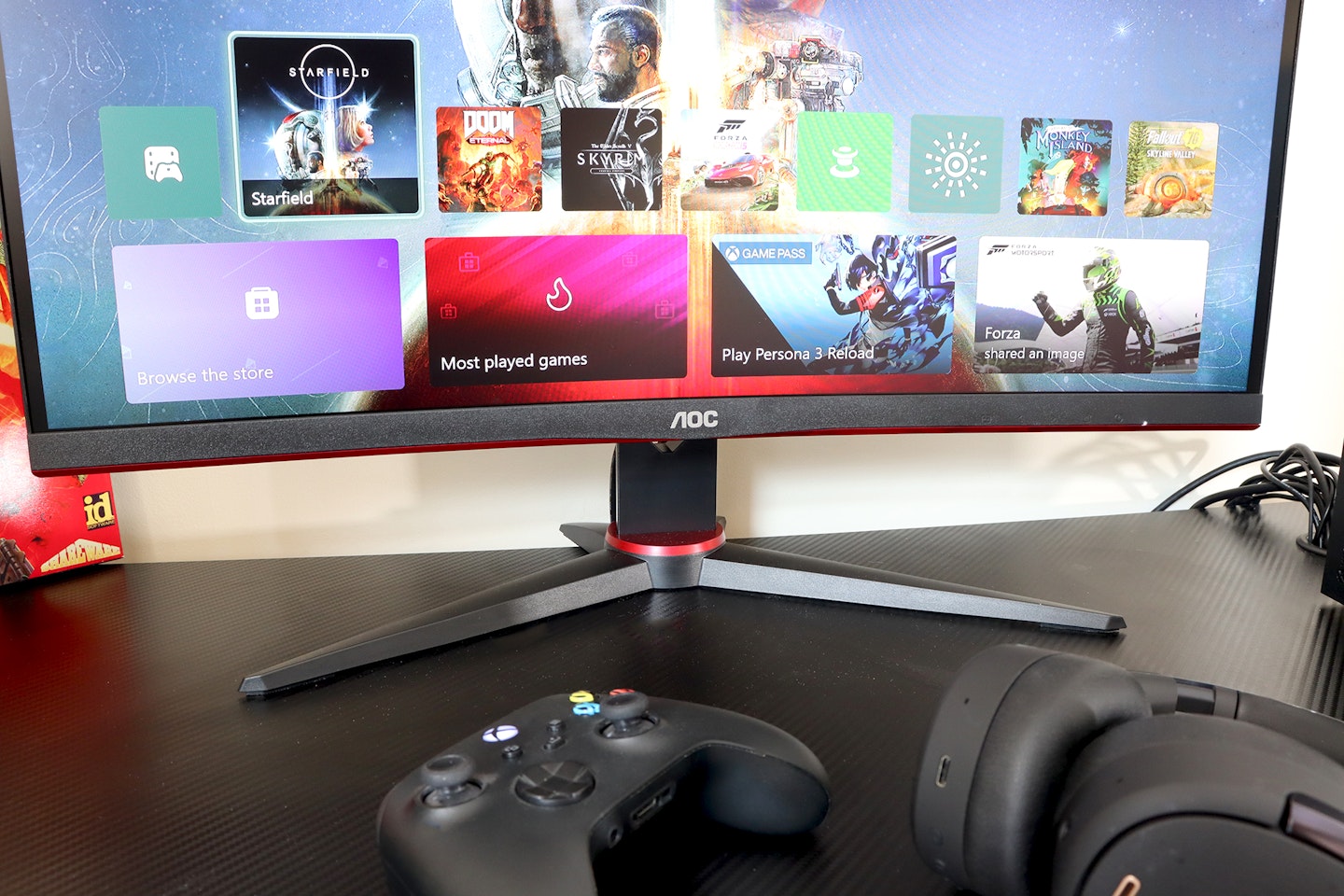
Overall, I would totally recommend the AOC Gaming CQ27G2SE monitor. It’s perfect for anyone looking for more immersion thanks to the curved screen, but also gives enough control over picture settings to get your graphics looking just the way you want them. For me, the joint stars of the show are the 165Hz refresh rate and quick response time. Any gamer looking to enjoy their games at higher framerates will see a serious uptick in smooth and detailed motion and super-low latency. Plus, the addition of gamer-centric features like the framerate counter, Shadow Control and HDR support finish off this budget-friendly gaming monitor package nicely.
Tech note: If you’re planning on using a console with this monitor, bear in mind that it has no built-in speakers. Aside from using headphones on either the console or the monitor's headphone jack, PS5 users will need to have an external USB speaker or USB-to-Bluetooth adapter for sound; and Xbox Series X users will need to rely on hooking a speaker up to the monitor's 3.5mm jack, or use an HDMI Audio Extractor to pipe audio to an external speaker system using a cable.
More items to consider
This monitor from Dell shares 95% of the features of the AOC, with only minor differences and the fact it’s a bit brighter at 350 nits and costs a little more. It’s got the same curve, same refresh rate and same size VA screen. Style-wise though, if you want less of a gamer look, this monitor is a good low-key option.
This screen from MSI is, again, very close to the spec of the AOC. It manages to come in a little cheaper and squeeze an extra 5Hz into the refresh rate at 170Hz. It’s close in design to the AOC too, but only supports standard HDR rather than AOC’s HDR10.
Want the size but not the curve? We reviewed the ASUS TUF Gaming VG289Q monitor recently and our tester, Kyle Purves, gave it a glowing five-star rating.
Who tested it?
Chris Duffill is one of the writers at What’s The Best, specialising in audiovisual technology. A gamer since the days of the Vic 20 and Sinclair ZX Spectrum, he enjoys collecting retro gaming hardware and software as well as playing on the latest next-gen consoles and PCs. He has also been a graphic designer and videographer, with extensive experience in various monitor and television display technologies.
How the product was tested
I tested the AOC Gaming CQ27G2SE monitor for around 10 days. It was connected to my Xbox Series X and PC via the included high-speed HDMI cable. I played a wide variety of games on it for long sessions in both daylight and at night, including Fallout 76, Skyrim, Starfield, DOOM Eternal, Forza Horizon 5, Rocket League and Streets Of Rage. I monitored the reported framerate of each game using the monitor’s on-screen display for consistency and stability. I also used the Xbox’s screen calibration tools to tweak the picture settings and also to report on the monitor’s available modes.
How we test products at What's The Best
Real people, real reviews and trusted buying advice.
Tired of confusing tech reviews? At What's The Best, we cut through the jargon with down-to-earth product evaluations. Our team of experienced reviewers puts everyday gadgets to the test, using them just like you would. We don't waste time on unrealistic scenarios; instead, we focus on real-world performance that matters to consumers.
This means unbiased buying advice you can trust. We only review products that are significant and relevant, so you can be sure you're getting the latest insights. Haven't seen a review for what you're looking for? Don't worry, we're constantly adding new products to our growing catalogue.
For in-depth details on our testing process, visit our dedicated tech and electronics how we test page.
Chris Duffill is a Senior Tech Writer and Reviewer for What's The Best. His background includes writing, editorial, marketing, design, video production and photography.
He specialises in home entertainment and audiovisual tech, including speakers, amplifiers, turntables, streaming media players, and TVs. He is also one of our resident experts in computing (PCs, tablets, smartphones, smartwatches), DSLR photography and all kinds of digital cameras. He also writes about retro gaming, game consoles and various electronic gadgets. If it plugs in, lights up or makes a noise, he’ll write about it.
Subscribe to the What’s The Best Newsletter to keep up to date with more of the latest reviews and recommendations from the rest of the What’s The Best team.













